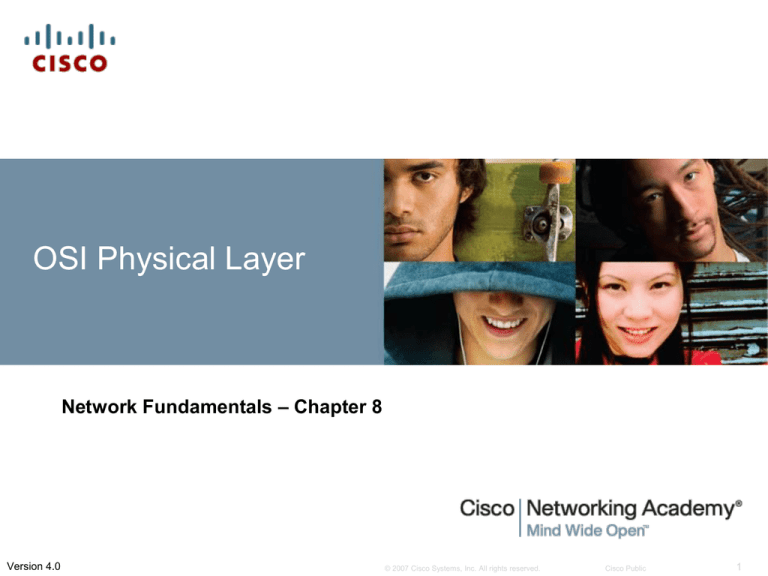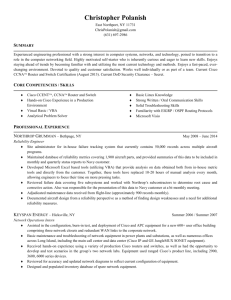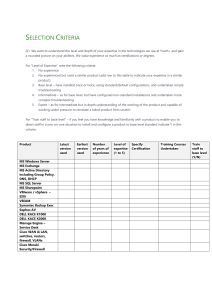
OSI Physical Layer
Network Fundamentals – Chapter 8
Version 4.0
© 2007 Cisco Systems, Inc. All rights reserved.
Cisco Public
1
Fiber Media
Copper uses electrical voltage to represent data.
Fiber-optic cable uses light pulses conducted through
special glass conductors to carry data.
Fiber has greater bandwidth and can run much farther
than cable without needing a signal enhanced,
but the higher cost of fiber-optic cable and connectors,
+ special training required for installing + handling fiber.
© 2007 Cisco Systems, Inc. All rights reserved.
Cisco Public
2
Fiber Media
Because fiber does not carry voltage and current =
immune to the earth ground and lightning concerns.
Usually considered the best choice for backbone
connections between floors and wiring closets in large
buildings and for connections between buildings on a
campus.
© 2007 Cisco Systems, Inc. All rights reserved.
Cisco Public
3
Fiber Media
Fiber-optic cable starts with a core strand of glass or
special plastic on which the light signal travels.
Around the glass is cladding, a special material that
reflects escaping light into the core.
Outer layers protect and strengthen the vulnerable
center core from moisture and damage.
© 2007 Cisco Systems, Inc. All rights reserved.
Cisco Public
4
Fiber Media
There are two basic types of fiber-optic cable:
• single-mode - most commonly used by telephone companies and in
data installations as backbone cable.
• multimode - usually the fiber-optic cable used with networking
applications such as FDDI and ATM
© 2007 Cisco Systems, Inc. All rights reserved.
Cisco Public
5
Wireless Media
Wireless media carry electromagnetic radio signals that
represent the binary data of the data-link frame.
Transmit and receive signals through the medium of the
open atmosphere = open areas are best
Within buildings, interference occurs from physical
objects such as
•walls, metal air ducts,
•and floors and
•machinery.
•+ subject to degradation
•microwave ovens,
•fluorescent lighting,
•phones and Bluetooth devices.
© 2007 Cisco Systems, Inc. All rights reserved.
Cisco Public
6
Wireless Media
Four common data communications standards that apply to
wireless media:
■ Standard IEEE 802.11: Commonly referred to as Wi-Fi, 802.11 is a
wireless LAN (WLAN) technology that uses a contention or
nondeterministic system with a carrier sense multiple access/collision
avoid (CSMA/CA) media access process.
■ Standard IEEE 802.15:Wireless Personal-Area Network (WPAN):
Commonly known as Bluetooth, 802.15 uses a device-pairing process
to communicate over distances from 1 to 100 meters.
■ Standard IEEE 802.16: Commonly known as WiMAX (Worldwide
Interoperability for Microwave Access), 802.16 uses a point-tomultipoint topology to provide wireless broadband access.
■ Global System for Mobile Communication (GSM): Includes physical
layer specifications that enable the implementation of the Layer 2
General Packet Radio Service (GPRS) protocol to provide data
transfer over mobile cellular telephony networks.
© 2007 Cisco Systems, Inc. All rights reserved.
Cisco Public
7
Wireless Media
© 2007 Cisco Systems, Inc. All rights reserved.
Cisco Public
8
Summary
© 2007 Cisco Systems, Inc. All rights reserved.
Cisco Public
9
© 2007 Cisco Systems, Inc. All rights reserved.
Cisco Public
10




